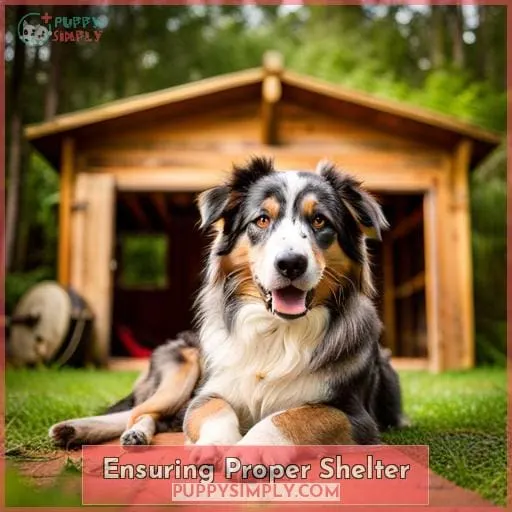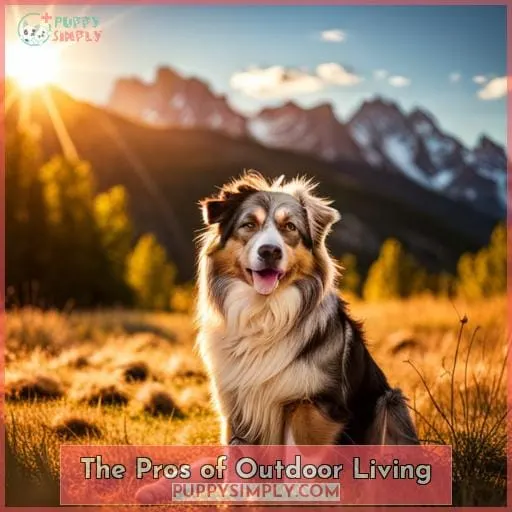This site is supported by our readers. We may earn a commission, at no cost to you, if you purchase through links.
 Whether you’re seeking belonging or safety, understanding Aussies starts with knowing their nature.
Whether you’re seeking belonging or safety, understanding Aussies starts with knowing their nature.
Were these pups bred as outdoor dogs? Do they like the cold?
Providing proper shelter and water enables their comfort outdoors, but consider their needs for mental stimulation too.
Balancing exercise and extreme temperatures remains key so your bond with this loyal breed stays healthy and safe.
Table Of Contents
- Key Takeaways
- Were Aussies Bred as Outdoor Dogs?
- Do Aussies Like the Cold?
- Ensuring Proper Shelter
- An Aussie’s Comfort Outdoors
- What Age Can Aussies Sleep Outside?
- Providing Water Access Outside
- The Pros of Outdoor Living
- The Cons of Outdoor Living
- An Aussie’s Outdoor Needs
- Frequently Asked Questions (FAQs)
- How much time should I spend interacting with my Aussie if it lives outdoors?
- What are some signs my Aussie is uncomfortable or unhappy living outdoors?
- How can I make sure my Aussie gets enough exercise if it lives outside?
- What steps should I take to socialize my Aussie if it lives outdoors?
- How can I provide mental stimulation for my Aussie while it’s outside?
- Conclusion
Key Takeaways
- Australian Shepherds can withstand cold temperatures with proper shelter like an insulated dog house.
- Monitoring the dog for signs of discomfort or health issues is important when kept outdoors.
- Provide activities, toys, and space for exercise to meet their high energy needs.
- An enclosed, securely fenced yard provides safety and space to roam for this active breed.
Were Aussies Bred as Outdoor Dogs?
Originally bred as herding dogs, Aussies weren’t specifically intended for permanent outdoor living, though they can withstand cold temperatures if given proper shelter.
As a breed developed to work long hours outside, Aussies are equipped to handle outdoor conditions for periods of time. However, their origins didn’t make them dogs that were meant to live their whole lives outside without refuge.
Aussies love being active outdoors, but they cherish their people and prefer relaxing inside when their work is done.
With their lush double coats protecting them from precipitation and cold, Aussies can remain comfortable in chillier climates given a dry, draft-free enclosure.
However, most Aussies will choose the warmth and company indoors over even the best outdoor facilities.
Their breeding history allows for outdoor exposure, but modern Aussies truly shine as inside companions.
Do Aussies Like the Cold?
Having a double-layer coat protecting them from frigid temperatures, Aussies can withstand cold climates quite well as long as their other needs are met.
- Provide a cozy, insulated shelter for them to retreat to when resting.
- Bundle them up in weather-appropriate gear like booties and coats for outdoor winter activities.
- Monitor for signs of discomfort or health issues aggravated by the cold weather conditions.
As working dogs bred to herd livestock in all weather conditions, Australian Shepherds are no strangers to cold climates. Their thick, protective fur coat and high activity levels allow them to happily play outside in the winter as long as you provide a warm, dry shelter for them to cozy up in when they need a break from the elements.
Simply adjust their walks and playtime to their comfort level, and your Aussie can thrive while sleeping outside in the cold.
Ensuring Proper Shelter
You’ll need to provide your Aussie with a properly insulated shelter so they can stay warm and dry if you’re letting them sleep outside.
An outdoor dog house should have:
- A slanted roof
- A raised floor
- Weatherproof materials like treated wood or plastic
Insulate the walls and ceiling with solid foam boards, and use plenty of cedar chips or straw bedding for warmth.
Make sure there’s a door flap to keep wind and rain out while allowing ventilation.
You may need adjustable panels on the door or windows that can open or close depending on temperatures.
Check that the shelter is securely anchored for safety in storms.
Providing a cozy, insulated place for your Aussie to retreat from the elements is essential if they’ll sleep outdoors.
An Aussie’s Comfort Outdoors
Many of your Aussie’s comfort needs outdoors can be met by providing proper shelter, sufficient space, mental stimulation, and monitoring of weather conditions.
An Australian Shepherd’s comfort in an outdoor environment depends greatly on adapting to weather conditions.
In warm climates, ensure ample shade, ventilation, and fresh water.
Cold conditions call for an insulated shelter.
Beyond physical needs, an Aussie’s happiness outdoors requires activities and toys that provide mental stimulation.
Make time for play sessions, walks, and training.
Ensure your Aussie has space for vigorous exercise.
Attentiveness to behavioral cues indicating discomfort, such as whining or destructive chewing, can prevent issues.
Providing for an Aussie’s basic needs while respecting its innate weather adaptation supports healthy, happy outdoor living arrangements.
What Age Can Aussies Sleep Outside?
Typically, you’d let your Aussie begin sleeping outside once it reaches 6 months old and has a protective double-coat to keep it warm.
By this age, your puppy has gone through key preparation to transition safely outdoors.
This includes:
- Gradual temperature changes from indoor to outdoor over weeks
- Outdoor training on commands and manners
- Socialization to sights and sounds
Setting up proper shelter is also vital before 6 months, whether that means an enclosed dog house or a sectioned-off porch area with beds and toys.
Provide water access as well.
The 6-month mark allows your Aussie to better regulate its temperature and have the behavioral skills to be comfortable outside.
But supervision, especially at first, ensures this major change goes smoothly.
Providing Water Access Outside
When keeping your Aussie outside, you must ensure they have constant access to fresh, clean water.
Use elevated, tip-proof bowls to prevent spills and contamination.
Replenish water at least twice daily in warm months.
Use heated bowls or refresh water more often in winter to prevent freezing.
Place multiple bowls around the yard so water is always in reach.
Aussies sleeping outdoors have increased hydration needs. Ensuring fresh, clean water through proper bowl placement and frequent refilling is crucial for their health. Adjust water changing frequency based on climate, checking more often on hot summer days and taking steps to prevent freezing in winter.
With good outdoor hydration access, your Aussie can stay happy and healthy while enjoying yard time.
The Pros of Outdoor Living
When considering outdoor living for your Aussie, recognize the breed’s high energy and exercise needs.
Having ample outdoor space allows your dog freedom to run and play.
An enclosed backyard also provides security while giving your Aussie opportunities for natural behaviors like exploring, patrolling territory, and chasing prey substitutes.
Exercise and Space
You need a fenced yard or frequent walks and runs for proper outdoor living with your Aussie.
Outdoor playtime and canine exercise are essential for an Aussie’s health and happiness.
Secure yards allow safe, open-air socialization benefits while preventing escapes.
Daily walks, runs, and interactive games will provide the physical and mental stimulation your energetic companion needs.
Monitoring their outdoor activities ensures appropriate exercise and space for contentment.
Frequent outdoor playtime allows your energetic Aussie the roaming room and socialization they desire for happiness and health.
A securely fenced yard gives them space to zoom and stimulates natural instincts without endangering them or others.
Interactive games and daily runs provide the intensive exercise the breed requires, preventing boredom and destructive behaviors.
Their high intelligence necessitates continuous physical and mental challenges that outdoor freedom facilitates.
Temperature Control
Their double-layer coat acts as your Aussie’s built-in air conditioning, protecting them from heat and cold as outdoor dogs.
This insulation allows them to thrive in many climates.
Still, extreme weather requires precautions like climate-controlled shelters, cooling pads, or winter jackets.
Monitoring your dog closely and adjusting its outdoor setup by season is key for health.
The Cons of Outdoor Living
You must consider that outdoor-only living fails to provide Aussies with needed mental engagement.
Their high intelligence means they require activities to occupy their minds, which is difficult to guarantee when left outside alone for long stretches.
Extreme hot or cold weather also poses health risks that you must mitigate through proper shelter, airflow, hydration, and limits on exposure times.
Mental Stimulation
Lack of mental engagement makes Aussies restless.
These brilliant dogs need daily stimulation to stay happy and healthy, whether through training, games, or puzzles.
Without enough mental challenges outside, boredom and frustration set in.
This leads to destructive digging, chewing, barking, and escaping attempts, which troubles neighbors.
Providing a rotation of puzzle toys, training new commands, playing scent and search activities also known as canine enrichment, setting up challenging agility equipment, teaching new tricks by hiding treats to discover—you can meet their needs despite outdoor living.
Extreme Temperatures
One of the risks of outdoor living for Aussies is the extreme temperatures they may be exposed to.
- Hot summer heat without shade can cause overheating and dehydration.
- Bitter winter cold requires extra insulation in their shelter.
- Know appropriate temperature guidelines for the breed.
Providing insulating and weatherproof shelter is crucial for Aussies outdoors, along with taking special winter and summer precautions to keep them comfortable.
An Aussie’s Outdoor Needs
Providing your Aussie companionship and mental stimulation while meeting their physical requirements for shelter, space, and temperature regulation lets them thrive in an outdoor environment.
Energize their minds through interactive play sessions, obedience training, and puzzle toys.
Equip their space with proper insulation, bedding, and heating for winter.
Socialize them frequently with people and compatible canines.
Adolescent and adult Aussies can better regulate their temperature and may enjoy sleeping outside, but very young and senior dogs need indoor monitoring.
Check on outdoor Aussies often, never leaving them alone for prolonged periods.
With attentive care and preparation, your loyal companion can flourish while sleeping under the stars.
Frequently Asked Questions (FAQs)
How much time should I spend interacting with my Aussie if it lives outdoors?
Your Mini Aussie needs at least one hour of quality interaction daily: playing, training, exercising.
More time together is ideal; this loyal breed thrives on human companionship.
What are some signs my Aussie is uncomfortable or unhappy living outdoors?
Changes in an Aussie’s behavior show its unhappiness outside.
With separation anxiety, it may:
- Pace
- Bark excessively
- Chew destructively
- Scratch doors
- Eliminate indoors
- Drool
Lethargy, trembling, hiding, loss of appetite, aggression, or reactivity also signal discomfort.
Frequent interaction relieves its stress.
How can I make sure my Aussie gets enough exercise if it lives outside?
Plan regular exercise and activities for your Aussie:
- Take it on long walks, runs, and hikes.
- Engage in active playtime twice daily, like tug-of-war and fetch.
- Rotate through different toys to prevent boredom.
Also, enroll in agility or obedience classes for mental stimulation.
What steps should I take to socialize my Aussie if it lives outdoors?
Bring your Aussie inside regularly to socialize with people and other pets.
Take it on walks to meet neighbors and dogs at parks.
Enroll in training classes for socialization.
Aussies are very sociable, so interact frequently if kept outdoors.
How can I provide mental stimulation for my Aussie while it’s outside?
Place interesting toys around the yard and hide treats or kibble to provide mental stimulation.
Rotate novel objects to prevent boredom.
Engage your Aussie’s natural herding instincts with balls or toys on ropes.
A bored dog is a destructive dog, so keep that busy mind working.
Conclusion
Ultimately, Australian Shepherds can thrive outdoors with proper preparation.
Providing shelter, water, mental engagement, and monitoring extreme temperatures enables their natural herding instincts while keeping them healthy.
With an understanding of their needs for exercise and climate control, plus diligent care, your loyal Aussie will embrace outdoor adventure at your side.















